The Copa America is just around the corner and this latest edition of the tournament brings a unique feature.
With the competition being held in the United States, the USMNT and five other CONCACAF representatives will feature in this year’s edition.
This will give an uncommon opportunity for the stars of North American football to demonstrate their credentials in one of the most prestigious international tournaments.
In this scout report, we will provide an analysis of three up-and-coming midfielders from the CONCACAF nations who could potentially be vital if their nation has a chance of progressing through the latter stages of the competition.
This tactical analysis will highlight the strengths and weaknesses that all three players demonstrated this season at club level and what role they may have in their respective nations’ tactics in the tournament.
Johnny Cardoso – United States
Born in New Jersey, Cardoso’s football development occurred in his parent’s native Brazil.
A product of the Internacional youth academy, the 22 year old went on to make over 100 first team appearances for the Porto Alegre club.
In January, Cardoso made the move to Europe and is now plying his trade at Andalucian club Real Betis in La Liga.
In Betis’s 4-2-3-1, Cardoso has been deployed as a holding midfielder in a double pivot.
This role has allowed for his strengths to be best utilised.
Cardoso’s key attribute is his ability to defend 1v1.
He has won 71.6% of his defensive duels in La Liga, the second-highest by any midfielder in the division.
This is best displayed during the defensive transition, where he is always quick to react to his team losing the ball.
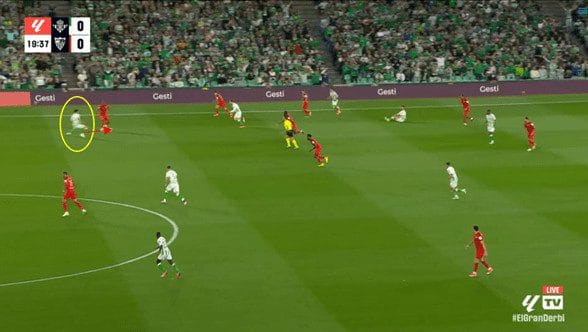
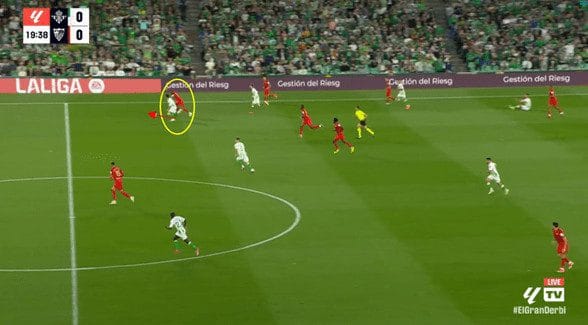
In this example, we see Cardoso quickly pressing the opponent who is receiving the opposition’s first pass since they have regained possession.
Cardoso does brilliantly to get into a position where he cuts of any passes into the midfield.
This then allows him to have a clear 1v1 with his opponent, who he easily tackles and wins the ball from.
Cardoso’s defensive capabilities also can be found in the excellent positions he takes when providing cover for teammates deep in his own half.
Cardoso can quickly spot potential danger and is fast to provide cover for any teammates that have left their position.
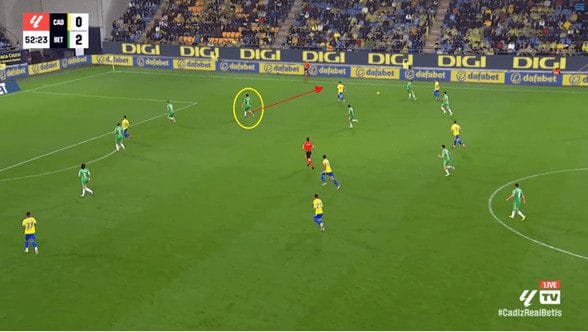
Here, we see Real Betis’s left back diligently pressing his direct opponent.
Despite this being required, it has left a massive gap down the left flank to be exploited.
Cardoso is quick to spot a dangerous run in this area and provides the needed cover to allow him to put the attack to a stop.
In possession, Cardoso’s primary strength is giving sufficient support from behind the ball.
Often, he can be seen providing angles for his teammates so that they can recycle possession.
In these situations, Cardoso is excellent at passing the ball off to a teammate in one or two touches, and he never appears to lose composure under pressure.
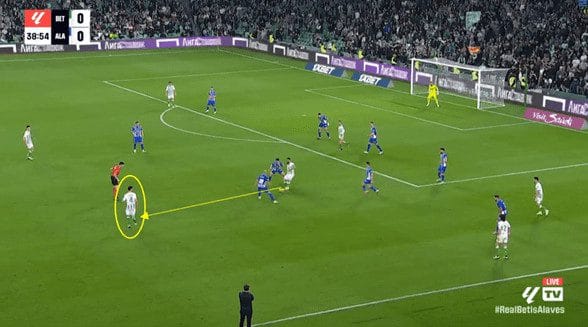
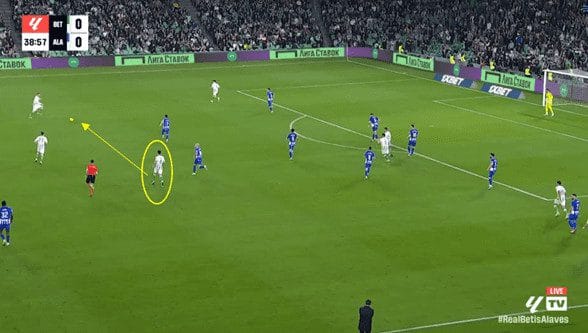
We see a prime example of this.
Cardoso provides a supporting angle from behind to a teammate who can’t progress the ball.
Cardoso receives the ball and is quick to move it on to a player in space.
Although Cardoso is technically proficient at maintaining possession, his weakness is found when he attempts to progress play.
He has only completed 16% of his attempted through balls and has only averaged 2.78 long passes per 90.
Cardoso fails to find passes that can unlock the last line of defence and often struggles when called upon to do so.
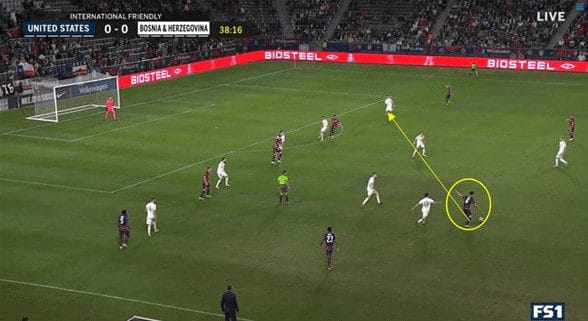
Here, we see Cardoso has picked up the ball in a deep position.
He attempts to play a long ball over the top of the defence to an advancing teammate.
He mishits the ball, getting the weight and direction all wrong, easily giving it back to the opposition.
In conclusion, I believe that Cardoso has an important role for the USMNT in this tournament.
He will compete with AC Milan’s Yunus Musah for the holding midfielder role in the side’s 4-3-3 system.
When comparing the two, it’s evident what both bring to the table.
Musah averaged 2.38 shot-creating actions per 90 this season, compared to the 1.42 that Cardoso averaged.
Musah was also considerably superior in progressive runs and progressive passes.
However, Cardoso has a clear advantage when it comes to the defensive side of the game.
Cardoso averages 3.24 tackles per 90 compared to Musah, who averages 1.52.
Cardoso also significantly trumps Musah in tackles made in the defensive 1/3.
This proves that both players can be utilised at different stages of matches and the tournament to give the USA the best chance of success.
Ismaël Koné – Canada
Over the past season and a half, Ismaël Koné has firmly cemented himself as an EFL Championship player at Watford.
The 22-year-old made the move from CF Montreal in January 2023 and has become an established player for both club and country.
The Ivory Coast-born midfielder plays as a classic eight and has several attributes to his game that could allow him to have a real impact in the Copa America.
Kone has a wonderful ability to glide past opponents, turning them easily when pressed.
This ability to go by defenders when under pressure allows him to take the ball around his opponents to give himself the free space to progress play.
Kone has averages 2.57 progressive carries per 90 this season.
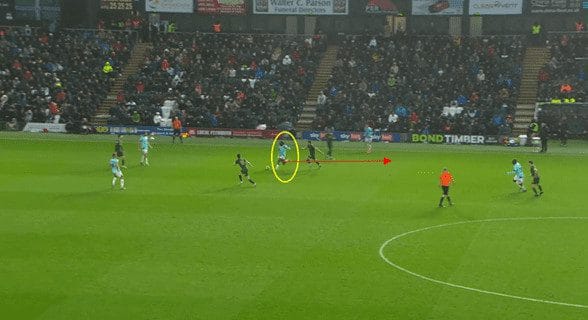
In this example, we see a prime example of Kone’s ability to go by players.
Despite being pressed intensely with his back to goal, he can lose his opponent easily, allowing him to pass forward.
Once Kone is in the final third, he possesses the quality to unlock defences.
He has a great ability to combine with his teammates on the edge of the penalty area to create opportunities.
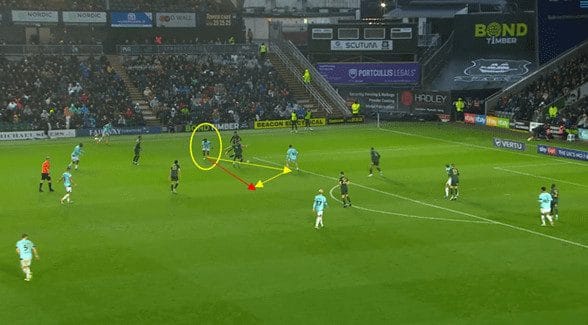
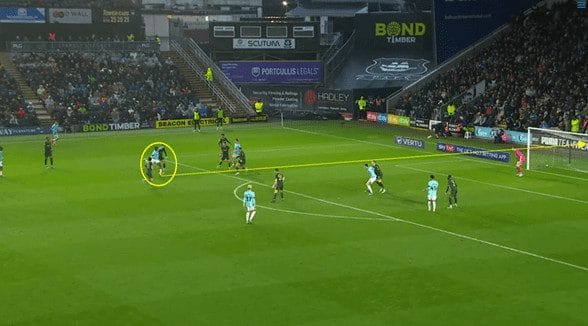
Here, we see Kone’s ability in the final third shine through.
After playing a neat one-two with a teammate on the edge of the box, space opens up for a shot.
Kone expertly bends the ball into the top corner, scoring an outstanding goal.
Despite possessing a great deal of quality on the ball, Kone is far from the most defensively reliable player.
Comparatively with midfielders in the EFL Championship this season, he has a percentile rank of 21 when it comes to making tackles and a percentile rank of 19 in interceptions.
One reason for this is that Kone struggles to physically impose himself when competing for the ball.
He has only won 41 per cent of loose ball duels.
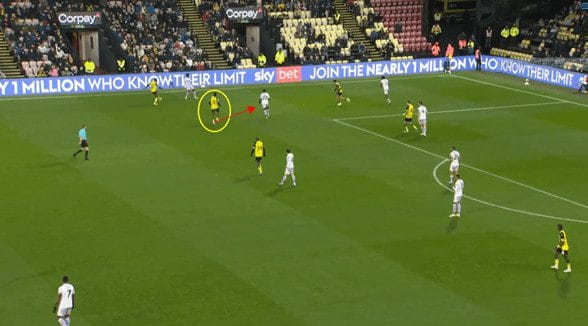
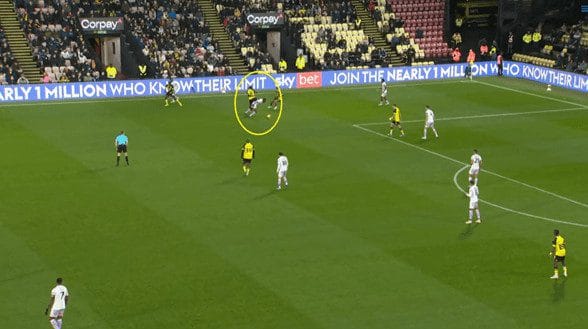
In this example, we see this demonstrated clearly.
Watford have done an excellent job during the defensive transition to pen in the opposition.
However, as a pass is played to the man that Kone is marking, he is easily held off as he attempts to challenge for the ball.
This allows the opposition to get out of what seemed to be an impossible situation.
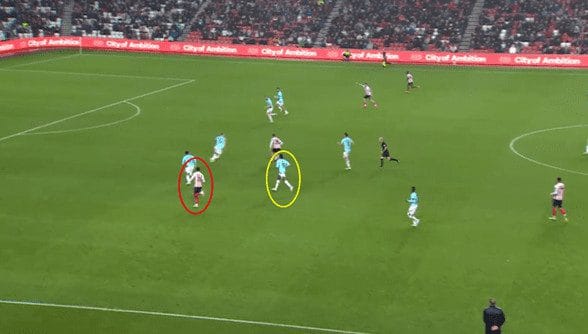
Kone also lacks defensive awareness and concentration, meaning that on occasions, he can lose the forward runs of opposing midfielders.
In this example, once Kone has pressed the player on the ball, he neglects his duty to follow him after the pass is made.
This leaves the opposition midfielder in a huge amount of space in a dangerous area.
Canada’s coach, Jesse March, is renowned for his high-pressing style, making it interesting to see how Kone will adapt to such a demanding system.
In Canada’s last two warm-up friendlies, Kone has been paired with Porto’s Stephen Eustáquio in midfield.
This could prove to be an effective partnership.
With Kone’s ability to run with the ball, Eustáquio falls into the percentile rank of 18 for both progressive carries and successful take-ons in Primeira Liga, compared with the league’s midfielders this season.
However, Eustáquio had this season a percentile rank of 81 when it came to tackles won in the top division in Portugal.
With both players able to account for their partner’s weaknesses, this partnership could be effective throughout Copa America.
Karoy Anderson – Jamacia
Born and raised in London, Anderson will cap off his first full season of first-team football with his first major tournament.
Having come through the ranks at Charlton Athletic, the 19-year-old has gone on to cement himself in the club’s first team.
He has played the fourth most minutes by a teenager in EFL League 1 this season and has earned himself a place in the Reggae Boys squad.
Anderson has the ability to play as an eight and a holding midfielder, demonstrating an incredible versatility that could be used throughout the tournament.
Anderson is dynamic, particularly with his off-the-ball movement.
When playing as an 8, he can be seen breaking from midfield to provide support to his teammates.
These runs not only allow Anderson to get on the ball in promising areas of the pitch, but they also open up space for his teammates to exploit.
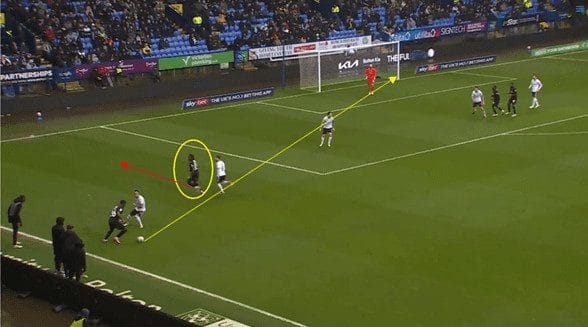
Here, we see Anderson breaking from midfield to provide an option for the man on the ball in the channels.
One of the opposition’s central midfielders closely followed Anderson, opening up space for the player on the ball to cut in and play a dangerous ball into the box, which resulted in a goal.
Despite Aderson’s effective movement, he struggles to provide significant end product once he’s in the final third.
A vital role of a number 8 is that they contribute to the team’s goals.
Anderson has provided only three goals and one assist.
His passes into the penalty area have a completion rate of only 36.7%, and he has averaged just 0.27 shots on target per 90 this season, proving his lack of quality in the final third.
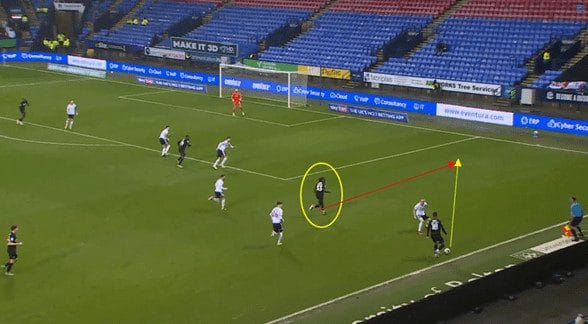
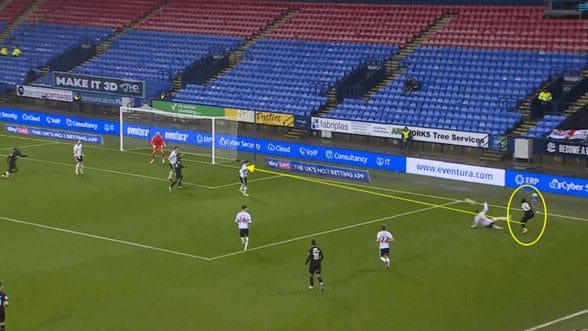
In this example, we see once again a quality run from Anderson, which has given him the opportunity to cross the ball.
His delivery is poorly aimed, and the ball is easily defended.
Being close to the byline, Anderson should have opted for a composed cutback to provide a better opportunity for his teammates.
Defensively, Anderson impresses greatly with his defensive discipline.
He is often quick to get into an effective position to provide compactness for his team.
When in these positions Anderson shows maturity beyond his years with his awareness of where his opponents are.
Anderson can be seen constantly scanning to check the movements of his direct opponent and other runners.
In these situations, Anderson is constantly communicating clearly to his teammates who need to be picked up.
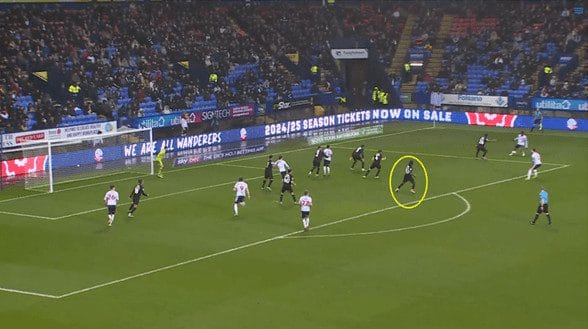
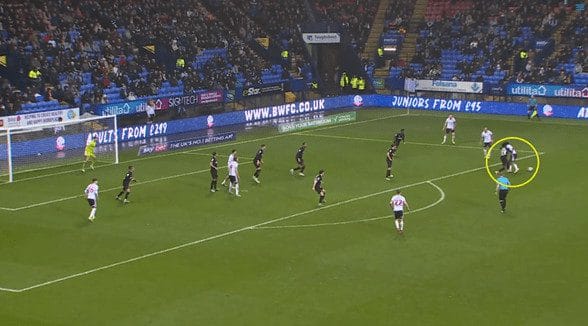
Here, we see Anderson in a position that provides good compactness for his team.
He has an open body and is constantly scanning to see where his opponents are.
As the ball moves inside, Anderson fulfils his role, putting pressure on the ball to help his team win it back.
Looking towards the tournament, this ability to remain defensively disciplined could be a real asset to his side.
In previous matches, Jamaica have lined up playing a 4-4-2 diamond.
This has seen Anderson play as the deepest midfielder.
Anderson has averaged more defensive duels and interceptions per 90 playing for Jamaica than for Charlton this season.
This passes on the creative responsibilities to established EFL Championship and Premier League players such as Kasey Palmer and Bobby DeCordova-Reid to provide the creative outlet.
Although Anderson may not start every game, his strengths could be a vital component if Jamaica are to have success.
Conclusion
This tactical analysis showed the strengths and weaknesses of three young midfielders who have the potential to contribute to their side’s success.
With the world keeping a close eye on North America as we approach the 2026 World Cup, it will be fascinating to see whether any of these prospects have the potential to become a talismanic figure for their nation in two years.

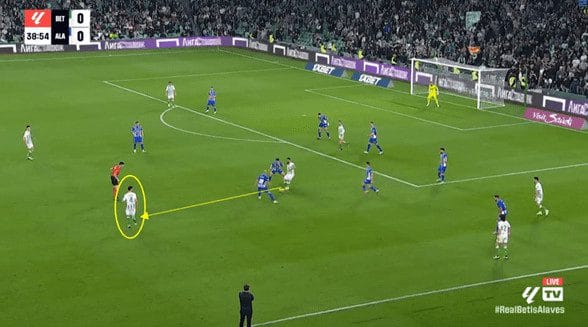



Comments